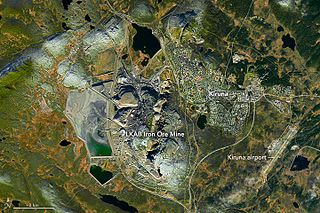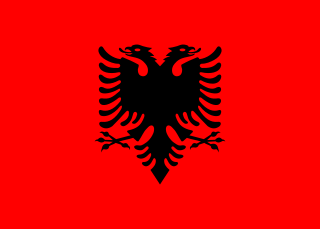The Cavnic mine is a large mine located in the northwest of Romania in Maramureş County, 26 km southwest of Baia Mare and 576 km north of the capital, Bucharest. Cavnic represents one of the largest polymetallic reserves in Romania having significant reserves of gold, silver, copper, lead and zinc amounting to 20 million tonnes of ore grading 1g/t gold, 30g/t silver, 2% lead, 3% zinc and 1% copper. The resources amount to 640,000 oz of gold, 19.2 million oz of silver, 400,000 tonnes of lead metal, 600,000 tonnes of zinc metal and 200,000 tonnes of copper metal.

The Bulqizë mine is a large mine located in central Albania in Dibër County, 40 kilometres (25 mi) east of the capital, Tirana. Bulqizë represents the largest chromium reserve in Albania and one of the largest in Europe having estimated reserves of 2.82 million tonnes of ore grading 45.83% chromium metal. The mine is part of the Bulqizë Massif, a 370 square kilometres (140 sq mi) area which has a rock thickness between 4 kilometres (2.5 mi) and 6 kilometres (3.7 mi) and contains 65 verified chromium deposits and occurrences. The deposit has been explored to depths of up to 1,300 metres (4,300 ft) and the geological reserves amount to 12 million tonnes of which 7.5 million tonnes grading over 38% chromium metal.

The Vlahna mine is a large mine located in northern Albania in Kukës County, 256 kilometres (159 mi) north-east of the capital, Tirana. Vlahna represents the second largest chromium reserve in Albania and one of the largest in Europe having estimated reserves of 2.56 million tonnes of ore grading 29.2% chromium metal. The mine is part of the Tropojë Massif, a 440 square kilometres (170 sq mi) area which has a rock thickness between 6 kilometres (3.7 mi) and 8 kilometres (5.0 mi) and contains 286 verified chromium deposits and occurrences. The deposit has been explored to depths of up to 300 metres (980 ft) and the geological reserves amount to 6.1 million tonnes grading 26.48% chromium metal.

The Kalimashi 1 mine is a large mine located near the village Kalimash in northern Albania in Kukës County, 80 kilometres (50 mi) north-east of the capital, Tirana. Kalimashi 1 represents the fourth largest chromium reserve in Albania and one of the largest in Europe having estimated reserves of 1.9 million tonnes of ore grading 20% chromium metal. The mine is part of the Kukës Massif, a 108 square kilometres (42 sq mi) area which has a rock thickness between 4 kilometres (2.5 mi) and 6 kilometres (3.7 mi) and contains 54 verified chromium deposits and occurrences. The deposit has been explored to depths of up to 300 metres (980 ft) and the geological reserves amount to 6.8 million tonnes grading 21.4% chromium metal.

The Kalimashi 3 mine is a large mine located near the village Kalimash in northern Albania in Kukës County, 80 kilometres (50 mi) north-east of the capital, Tirana. Kalimashi 3 represents the fifth largest chromium reserve in Albania and one of the largest in Europe having estimated reserves of 1.6 million tonnes of ore grading 20% chromium metal. The mine is part of the Kukës Massif, a 108 square kilometres (42 sq mi) area which has a rock thickness between 4 kilometres (2.5 mi) and 6 kilometres (3.7 mi) and contains 54 verified chromium deposits and occurrences. The deposit has been explored to depths of up to 300 metres (980 ft) and the geological reserves amount to 6.8 million tonnes grading 21.4% chromium metal.

The Qaf-Buall mine is a large mine located in central Albania in Dibër County, 40 kilometres (25 mi) east of the capital, Tirana. Qaf-Buall represents one of the largest chromium reserve in Albania and one of the largest in Europe having estimated reserves of 1.5 million tonnes of ore grading 39.44% chromium metal. The mine is part of the Bulqizë Massif, a 370 square kilometres (140 sq mi) area which has a rock thickness between 4 kilometres (2.5 mi) and 6 kilometres (3.7 mi) and contains 65 verified chromium deposits and occurrences. The deposit has been explored to depths of up to 1,300 metres (4,300 ft) and the geological reserves amount to 12 million tonnes of which 7.5 million tonnes grading over 38% chromium metal.

The Krasta mine is a large mine located in central east Albania, adjacent to the town of Krastë in Dibër County, 40 kilometres (25 mi) as the crow flies, east of the capital, Tirana. Krasta represents one of the largest chromium reserves in Albania and in all Europe, having estimated reserves of 2 million tonnes of ore grading 40% chromium metal.

The Zogaj mine is a large mine located near the village Zogaj in northern Albania in Kukës County, 256 kilometres (159 mi) north-east of the capital, Tirana. Zogaj represents one of the largest chromium reserve in Albania and one of the largest in Europe having estimated reserves of 1.238 million tonnes of ore grading between 24 and 28% chromium metal. The mine is part of the Tropojë Massif, a 440 square kilometres (170 sq mi) area which has a rock thickness between 6 kilometres (3.7 mi) and 8 kilometres (5.0 mi) and contains 286 verified chromium deposits and occurrences. The deposit has been explored to depths of up to 300 metres (980 ft) and the geological reserves amount to 6.1 million tonnes grading 26.48% chromium metal.

The Përroi Batrës mine is a large mine located near the village Kalimash in northern Albania in Kukës County, 80 kilometres (50 mi) north-east of the capital, Tirana. Përroi Batrës represents one of the largest chromium reserve in Albania and one of the largest in Europe having estimated reserves of 1.2 million tonnes of ore grading 20% chromium metal. The mine is part of the Kukës Massif, a 108 square kilometres (42 sq mi) area which has a rock thickness between 4 kilometres (2.5 mi) and 6 kilometres (3.7 mi) and contains 54 verified chromium deposits and occurrences. The deposit has been explored to depths of up to 300 metres (980 ft) and the geological reserves amount to 6.8 million tonnes grading 21.4% chromium metal.

The Kalimashi 2 mine is a large mine located near the village Kalimash in northern Albania in Kukës County, 80 kilometres (50 mi) north-east of the capital, Tirana. Kalimashi 2 represents one of the largest chromium reserve in Albania and one of the largest in Europe having estimated reserves of 0.4 million tonnes of ore grading 20% chromium metal. The mine is part of the Kukës Massif, a 108 square kilometres (42 sq mi) area which has a rock thickness between 4 kilometres (2.5 mi) and 6 kilometres (3.7 mi) and contains 54 verified chromium deposits and occurrences. The deposit has been explored to depths of up to 300 metres (980 ft) and the geological reserves amount to 6.8 million tonnes grading 21.4% chromium metal.

The Qaf-Perollaj mine is a large mine located near the village Zogaj in northern Albania in Kukës County, 256 kilometres (159 mi) north-east of the capital, Tirana. Qaf-Perollaj represents one of the largest chromium reserve in Albania and one of the largest in Europe having estimated reserves of 0.433 million tonnes of ore grading between 30 and 34% chromium metal. The mine is part of the Tropojë Massif, a 440 square kilometres (170 sq mi) area which has a rock thickness between 6 kilometres (3.7 mi) and 8 kilometres (5.0 mi) and contains 286 verified chromium deposits and occurrences. The deposit has been explored to depths of up to 300 metres (980 ft) and the geological reserves amount to 6.1 million tonnes grading 26.48% chromium metal.

The Thekna mine is a large mine located in central Albania in Dibër County, 40 kilometres (25 mi) east of the capital, Tirana. Thekna represents one of the largest chromium reserve in Albania and one of the largest in Europe having estimated reserves of 0.652 million tonnes of ore grading 38% chromium metal. The mine is part of the Bulqizë Massif, a 370 square kilometres (140 sq mi) area which has a rock thickness between 4 kilometres (2.5 mi) and 6 kilometres (3.7 mi) and contains 65 verified chromium deposits and occurrences. The deposit has been explored to depths of up to 1,560 metres (5,120 ft) and the geological reserves amount to 12 million tonnes of which 7.5 million tonnes grading over 38% chromium metal.

The Kiruna mine is the largest and most modern underground iron ore mine in the world. The mine is located in Kiruna in Norrbotten County, Lapland. The mine which is owned by Luossavaara-Kiirunavaara AB (LKAB), a large Swedish mining company, has an annual production capacity of over 26 million tonnes of iron ore. In 2008 the mine produced 27.5 million tonnes of iron ore. The Kiruna mine has an ore body which is 4 kilometres (2.5 mi) long, 80 metres (260 ft) to 120 metres (390 ft) thick and reaching a depth of up to 2 kilometres (1.2 mi). Since mining began at the site in 1898, the mine has produced over 950 million tonnes of ore.

The Aladağ mine is a large chromium ore mine located at Adana Province in southern Turkey, 229 km (142 mi) south of the capital, Ankara. Aladağ represents one of the largest chromium reserves in Turkey having an estimated reserve of 200 million tonnes of chromium ore, which contains 10.84 million tonnes of chromium metal at its grading of 5.42%.
The Orhaneli mine is a large mine in the west of Turkey in Bursa Province 331 km west of the capital, Ankara. Orhaneli represents one of the largest chromium reserve in Turkey having estimated reserves of 1 million tonnes of chromium ore grading 48% chromium metal. The 1 million tonnes of ore contains 480,000 tonnes of chromium metal.

The Musoshi Mine is an underground copper mine in the Katanga Province of the Democratic Republic of the Congo. The mineral rights are owned by the South African miner Metorex.
The Dubova mine is a large chromium mine located in western Romania in Mehedinți County, close to Dubova. Dubova represents one of the largest chromium reserves in Romania having estimated reserves of 2 million tonnes of ore grading between 38% and 52% chromium metal.
The Thaba mine is an open cast mine in the northwestern Bushveld Igneous Complex of South Africa near Thabazimbi in Limpopo. The Thaba Mines proven chromitite reserves amount to 23.6 million tonnes of ore grading 43.6% chromium. The 23.6 million tonnes of ore contains 10.3 million tonnes of chromium metal.
The Aganozersky mine is a large mine in the north-west of Russia in Republic of Karelia. Aganozersky represents one of the largest chromium reserve in Russia having estimated reserves of 181.6 million tonnes of ore grading 21.8% chromium. The 181.6 million tonnes of ore contains 38.7 million tonnes of chromium metal.
The Shalozersky mine is a large mine in the north-west of Russia in Republic of Karelia. Shalozersky represents one of the largest chromium reserve in Russia having estimated reserves of 206.1 million tonnes of ore grading 15.4% chromium. The 206.1 million tonnes of ore contains 31.7 million tonnes of chromium metal.









